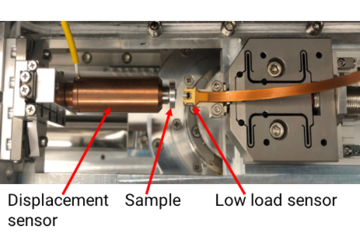All genres
481.
Talk
Building an ab-initio potentiostat in a standard DFT code with periodic boundary conditions. ELRC2019 - IPAM reuniuon workshop, Lake Arrowhead, CA, USA (2019)
482.
Talk
Computing and modelling solute-grain boundary interaction. Canadian Materials Science Conference, Vancouver, Canada (2019)
483.
Talk
Ab initio design strategies for NiMn-based FSMA. 6th Int. Conf. of Ferromagnetic Shape-Memory Alloys CFSMA, Prague, Czech Republic (2019)
484.
Talk
Thermodynamics of Grain Boundary Segregation and Interfacial Spinodal: A CALPHAD-based Modeling Approach and Near-atomic Scale Characterization. CALPHAD XLVIII, Singapore, Singapore (2019)
485.
Talk
Melting parameters from ab initio using the fast statistical sampling TOR-TILD approach: Applications to Al and Ni. CALPHAD XLVIII CONFERENCE, Singapore, Singapore (2019)
486.
Talk
Chemistry at Lattice Defects Probed at Atomic Scale. The 53rd Annual Meeting of the Israel Society for Microscopy, Tel Aviv, Israel, Tel Aviv, Israel (2019)
487.
Talk
Interaction of Chemistry and Structure at Lattice Defects at Atomic Scale. Russell Berrie Nanotechnology Institute, Technion, Haifa, Israel, Haifa, Israel (2019)
488.
Talk
Imaging single vacancies and atoms using joint FIM and APT experiments. Conference on Possibilities and Limitations of Quantitative Materials Modeling and Characterization, Bernkastel-Kues, Germany (2019)
489.
Talk
Exploiting large ab initio data spaces to design materials with superior mechanical propertiess. 2019 BIOVIA User Conference, Düsseldorf, Germany (2019)
490.
Talk
Chemistry and Structure of Lattice Defects. Physics Colloquium, Faculty of Physics, University Duisburg-Essen, Duisburg, Germany (2019)
491.
Talk
A fully ab initio approach to modelling electrochemical solid/liquid interfaces. Chemiekolloquium der Johannes Kepler Universität Linz, Linz, Austria (2019)
492.
Talk
Automated uncertainty analysis and quantification for high-precision DFT calculations. Workshop "Precision Quantification in DFT", Louvaine-la-Neuve, Belgien (2019)
493.
Talk
Automizing work flows in computational materials design. Traceability and securing of results as essential challenges of research in the digital age, Berlin, Germany (2019)
494.
Talk
Atomistic simulations of hydrogen-defect interactions in metals. Workshop "Hydrogen in Metals - current understanding and future needs", St Anne's College, Oxford, UK (2019)
495.
Talk
High-throughput optimization of finite temperature phase stabilities: Concepts and application. DPG Frühjahrstagung der Sektion Kondensierte Materie, Regensburg, Germany (2019)
496.
Talk
First-principles approach to model electrochemical reactions at the solid-liquid interface. Spring Meeting of the German Physical Society (DPG 2019), Regensburg, Germany (2019)
497.
Talk
κ carbide microstructures and the role of interfaces in high-Mn lightweight steels. High-Mn Steel 2019, Aachen, Germany (2019)
498.
Talk
From Atomistic Understanding to Engineering Design of Advanced Medium and High Manganese Steels. 4th International Conference on medium and high Manganese steels, Aachen, Germany (2019)
499.
Talk
Impact of Interstitial Alloying of High Entropy Alloys from First Principles. TMS 2019, San Antonio, TX, USA (2019)
500.
Talk
Modelling structural materials in realistic environments by ab initio thermodynamics. Hume-Rothery Award Symposium, TMS2019 Annual Meeting and Exhibition, San Antonio, TX, USA (2019)











